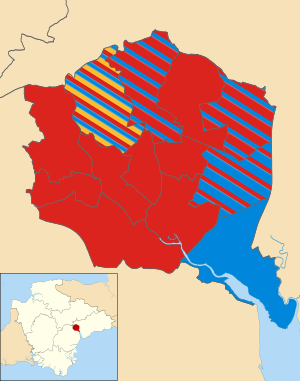Exeter City Council election, 2016
|
|||||||||||||||||
|
All 39 seats to Exeter City Council 20 seats needed for a majority |
|||||||||||||||||
|---|---|---|---|---|---|---|---|---|---|---|---|---|---|---|---|---|---|
|
|||||||||||||||||

Map showing the results the 2016 Exeter City Council elections by ward. Red shows Labour seats, blue shows the Conservatives, and yellow shows the Liberal Democrats. Striped wards indicate seats shared between parties.
|
|||||||||||||||||
|
|||||||||||||||||
The 2016 Exeter City Council election took place on 5 May 2016, to elect members of Exeter City Council in England. Following boundary changes, the entire council was up for election, and all 13 wards were contested, each electing three councillors. The election was held concurrently with other local elections held in England on the 5 May.
The council had been controlled by the Labour Party since 1990, which had held an outright majority since 2012. Labour won the Exeter election, extending their control to 30 seats, their highest ever share of the vote. The Conservatives came in second place with eight seats, losing four to Labour, while the Liberal Democrats won a single seat.
The election for the Devon and Cornwall Police and Crime Commissioner was also scheduled for the 5 May. Voters in Exeter would cast a separate ballot for the office, in conjunction with the residents of the rest of the Devon and Cornwall police area.
The elections to Exeter City Council were the first to be held since the Local Government Boundary Commission for England conducted a review into the electoral arrangements in Exeter. The review was prompted by the previous council that had a high level of electoral inequality, with some councillors representing many more voters than others. The old council consisted of 40 councillors from 18 wards, each of two or three councillors, which were elected by thirds over a four-year cycle, with elections to Devon County Council on the fourth year. This resulted in some wards having elections every year, while others would have one year in the cycle with no elections. The review resulted in the number of councillors being reduced to 39 and the number of wards reduced to 13, with each ward returning three councillors. The ward changes equalised the ratio of voters to councillors, and provided for the entire city being able to vote in local elections every year.
As a result of the review, for 2016 all seats on the council were up for election. The election used the plurality-at-large voting system; each voter was able to cast up to three votes, with the three candidates with the highest number of votes being elected. As the council will revert to electing by thirds in 2018, a number of councillors will serve partial terms in the interim. In each ward, the councillor who received the highest number of votes will serve a four-year term, the councillor with the second highest number a three-year term, and the councillor with the third-highest votes will have a two-year term. In future elections, each councillor will serve a full four-year term.
...
Wikipedia
